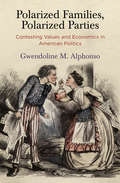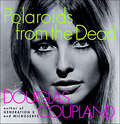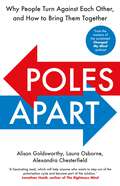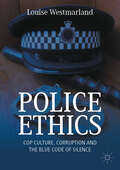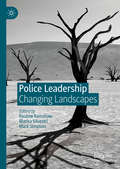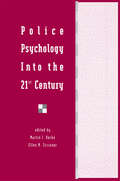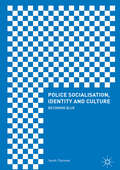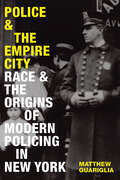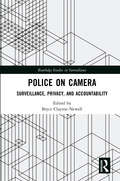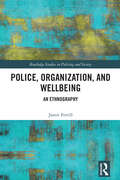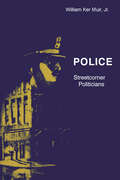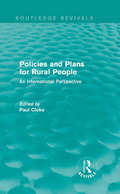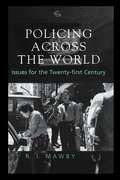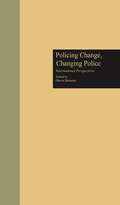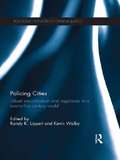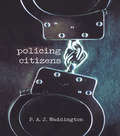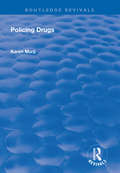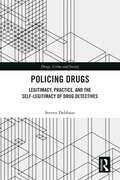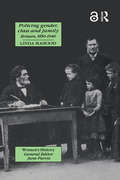- Table View
- List View
Polarized Families, Polarized Parties: Contesting Values and Economics in American Politics (American Governance: Politics, Policy, and Public Law)
by Gwendoline M. AlphonsoStruggles to define the soul of America roil the nation's politics. Debates over the roles of gays, lesbians, women, immigrants, racial and religious minorities, and disputes over reproductive and abortion rights serve as rallying points for significant electoral groups and their representatives in government. Although the American family lies at the core of these fierce battles, the alignment of family with social or cultural issues is only a partial picture—a manifestation of the new right's late twentieth-century success in elevating "family values" over family economics.Gwendoline Alphonso makes a significant contribution to the prevailing understanding of party evolution, contemporary political polarization, and the role of the family in American political development by placing family at the center of political and cultural clashes. She demonstrates how regional ideas about family in the twentieth century have continually shaped not only Republican and Democratic policy and ideological positions concerning race and gender but also their ideals concerning the economy and the state. Drawing on extensive data from congressional committee hearings, political party platforms, legislation sponsorship, and demographic data from the Progressive, post-World War II, and late twentieth-century periods in the United States, Polarized Families, Polarized Parties offers an intricate and sophisticated analysis of how deliberations around the ideal family became critical to characterizations of party politics. By revealing the deep historical interconnections between family and the two parties' ideologies and policy preferences, Alphonso reveals that American party development is more than a story of the state and its role in the economy but also, at its core, a debate over the political values of family and the social fabric it embodies.
Polaroids from the Dead: And Other Short Stories
by Douglas CouplandDouglas Coupland takes his sparkling literary talent in a new direction with this crackling collection of takes on life and death in North America -- from his sweeping portrait of Grateful Dead culture to the deaths of Kurt Cobain, Marilyn Monroe and the middle class.For years, Coupland's razor-sharp insights into what it means to be human in an age of technology have garnered the highest praise from fans and critics alike. At last, Coupland has assembled a wide variety of stories and personal "postcards" about pivotal people and places that have defined our modern lives. Polaroids from the Dead is a skillful combination of stories, fact and fiction -- keen outtakes on life in the late 20th century, exploring the recent past and a society obsessed with celebrity, crime and death. Princess Diana, Nicole Brown Simpson and Madonna are but some of the people scrutinized.
Poles Apart: Book 1 (Poles Apart #1)
by Franklin WattsCovered in vast expanses of ice and snow, and battered by gale-force winds, Antarctica is one of Earth's most isolated and hostile habitats. And yet many amazing animals and plants thrive in these extreme conditions.This book explores Antarctica, showing the plants and animals that survive here in the long dark winters and acute cold. Learn about ice floes and pack ice so heavy and hard they can tear a ship's hull and read about the amazing Antarctic fish who have anti-freeze in their blood. See the stunning Southern lights rippling across the sky in glowing greens and yellows and find out what sparkling diamond dust is.Because so few humans can live in such cold conditions, this means the region is mostly unspoilt, providing a great environment for scientific research. This book looks at the work that happens in Antarctica as well as exploring some of the problems that affect the region, such as climate change and toxic pollution.Oliver Averill's atmospheric illustrations provide a visual guide to one of our planet's extraordinary polar regions. Perfect for children aged 7+
Poles Apart: Why People Turn Against Each Other, and How to Bring Them Together
by Alison Goldsworthy Laura Osborne Alexandra ChesterfieldWhy do people become divided?What steps can we all take to reduce hostility and bring about understanding?Poles Apart has the answers.In Poles Apart, an expert on polarisation, a behavioural scientist and a professional communicator explain why we are so prone to be drawn into rival, often deeply antagonistic factions. They explore the shaping force of our genetic make-up on our fundamental views and the nature of the influences that family, friends and peers exert. They pinpoint the economic and political triggers that tip people from healthy disagreement to dangerous hostility, and the part played by social media in spreading entrenched opinions. And they help us to understand why outlooks that can seem so bizarre and extreme to us seem so eminently sensible to those who hold them.Above all, they show what practical and effective steps we can all take to narrow divisions, build respect for others, and create a greater degree of common understanding.____________________________________________________'Poles Apart is an extraordinary achievement: fresh, deeply authoritative, and entertaining on every page. Everyone talks about polarisation, but no one does it like Goldsworthy, Osborne, and Chesterfield. You'll finish this book wiser, kinder, and more hopeful than when you started it.' Jamie Susskind, author of Future Politics'A fascinating and thought-provoking analysis of the divisions between us, how we bridge them, how we reshape the world - and ourselves too. Essential reading.' Cathy Newman, presenter of Channel 4 News and author'Asks the best question I have ever heard. And, critically, offers solutions. A must read.' Rory Sutherland, Vice Chairman of Ogilvy UK, and author of Alchemy'Technology may have connected the world, but it's now being exploited to divide and polarise us. This is a pivotal moment for this book to be written, read and understood.' Peter Gabriel, musician
Police Conflict Management, Volume I: Challenges and Opportunities in the 21st Century
by Swen Koerner Mario S. Staller Benni ZaiserThis book, as part of a two volume set, provides a broad overview of the current state of research on conflict management in law enforcement contexts globally, with a focus on contemporary challenges and opportunities in policing globally and ethical considerations. They cover a wide range of interactions between police and the public. This volume (I) focusses on the challenges and opportunities, examining topics such as police legitimacy, police culture, violence, mental health, community relations and crisis situations. Volume II focusses on police training and education and the learning settings needed for police to professionally tackle contemporary challenges. These books bring together leading research that is determining the state of the art in communication, de-escalation, use of force, and other contemporary issues in policing, with practical Key Takeaways in each chapter. They broaden the field by focussing on research which goes beyond the US, including in Scandinavia, Switzerland, the Netherlands, Germany, the Republic of South Africa and Russia.
Police Conflict Management, Volume II: Training and Education
by Swen Koerner Mario S. Staller Benni ZaiserThis book, as part of a two volume set, provides a broad overview of the current state of research on conflict management in law enforcement contexts globally, with a focus on training and education. They cover a wide range of interactions between police and the public. This volume (II) focusses on training and education and the learning settings that play a prominent role in providing police officers with the knowledge structures, competencies, attitutes, and values that they need to professionally tackle contemporary challenges. Volume I focusses on the contemporary challenges and opportunities in policing and ethical considerations. These books bring together leading research that is determining the state of the art in communication, de-escalation, use of force, and other contemporary issues in policing, with practical Key Takeaways in each chapter. They broaden the field by focussing on research which goes beyond the US, including in Scandinavia, Switzerland, the Netherlands, Germany, the Republic of South Africa and Russia.
Police Ethics: Cop Culture, Corruption and the Blue Code of Silence
by Louise Westmarland"This book is an important analysis of how police themselves define and respond to police corruption and wrongdoing. It offers special insights into this hard to research issue because it is based on using similar techniques of study on samples of police over time and in different jurisdictions, all linked by an autoethnographic account by Professor Westmarland — an internationally celebrated expert on the topic — narrating her engagement with the problems of police corruption and culture. This provides a revealing account of variations over time and between places. Clearly and engagingly written this is essential reading for students, scholars, practitioners and policy makers concerned about policing and its legitimacy." -Robert Reiner, Emeritus Professor of Criminology, LSE "This is a lively and fascinating book which places our understanding of policing ethics, integrity and police corruption within a long term timeline. The author traces how a particular research technique within policing studies - the use of 'scenario' based surveys of police officers to test officers' attitudes to the seriousness of a series of possible forms of police misconduct and their willingness to report those forms to others - has been utilised in policing research over a 50 plus year history. It begins with US-based pioneering policing research in the 1970s and takes us through the use of, and lessons learnt by, scenario-based research in later decades in the UK and internationally. This includes, by way of an autoethnography, the author's own critical research over the past 20 years, revisiting some earlier published research on the theme. This book is essential reading for those studying police integrity and corruption and the wider field of police cultures." - Professor Steve Savage, Emeritus Professor of Criminology, University of Portsmouth. This book outlines over 20 years of in-depth research on police culture and the blue code of silence which is said to protect and perpetuate police misconduct. It discusses the existing literature and draws upon first-hand research with many serving police officers and some police support staff. These studies not only provide evidence of the police code but are also useful for examining why and how to prevent its ill-effects. A recent (post 1950s) history of police cultural research which concentrates on ethics and integrity is provided with reflections on change and a discussion of the College of Policing&’s introduction of a code of ethics in 2014. It asks whether anything has changed but mainly analyses the individual studies and what the potential lessons learnt are from the various scand
Police Interrogation and American Justice
by Richard A. Leo"Read him his rights." We all recognize this line from cop dramas. But what happens afterward? In this book, Richard Leo sheds light on a little-known corner of our criminal justice system--the police interrogation. Incriminating statements are necessary to solve crimes, but suspects almost never have reason to provide them. Therefore, as Leo shows, crime units have developed sophisticated interrogation methods that rely on persuasion, manipulation, and deception to move a subject from denial to admission, serving to shore up the case against him. Ostensibly aimed at uncovering truth, the structure of interrogation requires that officers act as an arm of the prosecution. Skillful and fair interrogation allows authorities to capture criminals and deter future crime. But Leo draws on extensive research to argue that confessions are inherently suspect and that coercive interrogation has led to false confession and wrongful conviction. He looks at police evidence in the court, the nature and disappearance of the brutal "third degree," the reforms of the mid-twentieth century, and how police can persuade suspects to waive their Miranda rights. An important study of the criminal justice system, Police Interrogation and American Justice raises unsettling questions. How should police be permitted to interrogate when society needs both crime control and due process? How can order be maintained yet justice served?
Police Leadership: Changing Landscapes
by Marisa Silvestri Mark Simpson Pauline RamshawThis book draws upon a range of theoretical and empirical research to explore contemporary debates about police leadership. Focusing upon leadership styles, ethics, integrity and professionalism, workforce diversity, legitimacy and accountability, it reviews the changing context and nature of leadership over time and explores the gains, losses, tensions and challenges that different leadership models bring to policing. Leadership is present at various levels within the police service and this collection reflects upon appropriate leadership qualities and requirements for different roles and at different ranks. The book also considers the difference between leadership and management in an attempt to capture fuller debates within police leadership. Part one surmises the contextual backdrop to current thinking and the primary challenges facing leadership in the police service. Part two highlights the changing face of leadership through an exploration of the call for greater diversity within the ranks of police leadership, and the final section examines police leadership beyond England and Wales. Through this, Police Leadership explores how the challenges facing police leadership in England and Wales share similarities with those in Scotland, Northern Ireland, Greece, North America, and Australia in the face of the pressures of political and economic uncertainty.
Police Psychology Into the 21st Century (Applied Psychology Series)
by Martin I. Kurke Ellen M. ScrivnerAs we approach the 21st century, there is a discernable shift in policing, from an incident-driven perspective to a proactive problem solving stance often described as "community policing." In this volume a panel of 21 psychologists examine the changing directions in policing and how such changes impact on psychological service delivery and operational support to law enforcement agencies. The book describes existing and emerging means of providing psychological support to the law enforcement community in response to police needs to accommodate new technology, community-oriented problem solving technology, crime prevention, and sensitivity to community social changes. Senior psychologists who are sworn officers, federal agents and civilian employees of federal, state and local law enforcement agencies comprise the team of chapter authors. Their perspectives encompass their collective experience "in the trenches" and in law enforcement management and administrative support roles. They discuss traditional applications of psychology to police selection, training and promotion processes, and in trauma stress management and evaluation of fitness for duty. Concerns related to police diversity and police family issues are also addressed, as are unique aspects of police stress management. Additional chapters are dedicated to establishing psychological service functions that currently are less familiar to police agencies than they are to other government and private sector service recipients. These chapters are devoted to police psychologists as human resource professionals, as human factors experts in accommodating to new technology and to new legal requirements, as organizational behavioral experts, and as strategic planners. This text is recommended reading for two groups: *police and public safety administators whose work takes them--or should take them--into contact with police psychologists; *practicing and would-be police psychologists concerned with the emerging trends in the application of psychology to police and other public safety programs.
Police Socialisation, Identity and Culture
by Sarah CharmanThis book reinvigorates the debate about the origins and development of police culture within our changing social, economic and political landscape. An in-depth analysis and appreciation of the police socialisation, identity and culture literature is combined with a comprehensive four-year longitudinal study of new recruits to a police force in England. The result offers new insights into the development of, and influences upon, new police recruits who refer to themselves as a "new breed" of police officer. Adding significantly to the police culture literature, this original and empirically based research also provides valuable insights into the challenges of modern policing in an age of austerity. Scholars of policing and criminal justice, as well as police officers themselves will find this compelling reading.
Police and the Empire City: Race and the Origins of Modern Policing in New York
by Matthew GuarigliaDuring the years between the Civil War and World War II, police in New York City struggled with how to control a diverse metropolis. In Police and the Empire City Matthew Guariglia tells the history of the New York Police Department to show how its origins were built upon and inseparably entwined with the history of race, ethnicity, and whiteness in the United States. Guariglia explores the New York City Police Department through its periods of experimentation and violence as police experts imported tactics from the US occupation of the Philippines and Cuba, devised modern bureaucratic techniques to better suppress Black communities, and infiltrated supposedly unknowable immigrant neighborhoods. Innovations ranging from recruiting Chinese, Italian, and German police to form “ethnic squads” to the use of deportation and federal immigration restrictions to control local crime—even the introduction of fingerprinting—were motivated by attempts to govern a multiracial city. Campaigns to remake the police department created an urban landscape where power, gender, sexuality, race, ethnicity, crime, and bodies collided and provided a foundation for the supposedly color-blind, technocratic, federally backed, and surveillance-based policing of today.
Police in the Hallways: Discipline in an Urban High School
by Kathleen NolanAs zero-tolerance discipline policies have been instituted at high schools across the country, police officers are employed with increasing frequency to enforce behavior codes and maintain order, primarily at poorly performing, racially segregated urban schools. Actions that may once have sent students to the detention hall or resulted in their suspension may now introduce them to the criminal justice system. In Police in the Hallways, Kathleen Nolan explores the impact of policing and punitive disciplinary policies on the students and their educational experience. Through in-depth interviews with and observations of students, teachers, administrators, and police officers, Nolan offers a rich and nuanced account of daily life at a Bronx high school where police patrol the hallways and security and discipline fall under the jurisdiction of the NYPD. She documents how, as law enforcement officials initiate confrontations with students, small infractions often escalate into &“police matters&” that can lead to summonses to criminal court, arrest, and confinement in juvenile detention centers. Nolan follows students from the classroom and the cafeteria to the detention hall, the dean&’s office, and the criminal court system, clarifying the increasingly intimate relations between the school and the criminal justice system. Placing this trend within the context of recent social and economic changes, as well as developments within criminal justice and urban school reform, she shows how this police presence has created a culture of control in which penal management overshadows educational innovation. Police in the Hallways also examines the prevalent forms of oppositional behavior through which students express their frustrations and their deep sense of exclusion. With compassion and clear-eyed analysis, Nolan sounds a warning about this alarming convergence of prison and school cultures and the negative impact that it has on the real lives of low-income students of color—and, in turn, on us all.
Police on Camera: Surveillance, Privacy, and Accountability (Routledge Studies in Surveillance)
by Bryce Clayton NewellPolice body-worn cameras (BWCs) are at the cutting edge of policing. They have sparked important conversations about the proper role and extent of police in society and about balancing security, oversight, accountability, privacy, and surveillance in our modern world. Police on Camera address the conceptual and empirical evidence surrounding the use of BWCs by police officers in societies around the globe, offering a variety of differing opinions from experts in the field. The book provides the reader with conceptual and empirical analyses of the role and impact of police body-worn cameras in society. These analyses are complimented by invited commentaries designed to open up dialogue and generate debate on these important social issues. The book offers informed, critical commentary to the ongoing debates about the implications that BWCs have for society in various parts of the world, with special attention to issues of police accountability and discretion, privacy, and surveillance. This book is designed to be accessible to a broad audience, and is targeted at scholars and students of surveillance, law and policy, and the police, as well as policymakers and others interested in how surveillance technologies are impacting our modern world and criminal justice institutions.
Police, Organization, and Wellbeing: An Ethnography (Routledge Studies in Policing and Society)
by Jamie FerrillBased on the study of a police organization in England, this book explores the role of social relations in the ways that people construct, mobilize, consume, and reconstruct meaning about wellbeing. Wellbeing is a powerful, institutionalized concept in police organizations across England and Wales. With the emergence of numerous policies, strategies, and practices that both explicitly and implicitly address wellbeing in the workplace, the concept has come to feature prominently. Wellbeing is addressed as an issue that needs to be understood intersubjectively by attending to the underlying social issues that shape how it is promoted or denied. After a theoretical exploration of police culture and wellbeing, the book traverses ethnographic data and captures insights from individuals across the organization’s hierarchy. It explores what individuals perceive wellbeing to mean and how they make sense of the concept. The book reveals discernible ideological-laden tensions across the hierarchy in terms of wellbeing constructions. By exploring these tensions, there is a potential to understand the constructions of wellbeing and the resultant implications for practice. This book will be of interest to academics, researchers, and students in policing, criminology, criminal justice, leadership/management, organizational behaviour, and wellbeing. Given its empirical focus and applicability to practitioners, it will also be of interest to a range of non-academics, including police officers and leaders, public servants, private organizations, policymakers, and human resources professionals.
Police, Politics and the Immigration-Crime Nexus: Speeches, Statistics and Testimonies of the Buenos Aires Context
by Federico Luis AbiusoThis book examines the relationship between immigration, crime, police and politics in the city of Buenos Aires during the Cambiemos ("Let's Change") administration, which took place in Argentina between 2015 and 2019. It draws on semi-structured interviews with migrants to offer insights into interactions between police and migrants, narratives of police violence, police attitudes towards migrants, the nexus between police and politics and the perception of the vulnerability of the migratory community of belonging to police action. Using a mixed methods approach, it also draws on secondary quantitative data regarding police practices of detention of migrants and examines political discourses around the immigration-crime association. In essence, it discusses the changes in attitude of the police towards different ethnic-national groups during the administration Cambiemos. In this sense, it presents empirical research and methodological insights from the Global South.
Police: Streetcorner Politicians
by William K. Muir Jr."This book . . . examines the problem of police corruption . . . in such a way that the stereotype of the crude, greedy cop who is basically a grown-up delinquent, if not an out-and-out robber, yields to portraits of particular men, often of earnest good will and even more than ordinary compassion, contending with an enormously demanding and challenging job."—Robert Coles, New Yorker "Other social scientists have observed policemen on patrol, or have interviewed them systematically. Professor Muir has brought the two together, and, because of the philosophical depth he brings to his commentaries, he has lifted the sociology of the police on to a new level. He has both observed the men and talked with them at length about their personal lives, their conceptions of society and of the place of criminals within it. His ambition is to define the good policeman and to explain his development, but his achievement is to illuminate the philosophical and occupational maturation of patrol officers in 'Laconia' (a pseudonym) . . . . His discussions of [the policemen's] moral development are threaded through with analytically suggestive formulations that bespeak a wisdom very rarely encountered in reports of sociological research."—Michael Banton, Times Literary Supplement
Policies and Plans for Rural People: An International Perspective (Routledge Revivals)
by Paul ClokeThis edited collection, first published in 1988, was the first title to bring international perspectives into the field of rural planning. Using a comparative approach and a broad range of case studies, including Britain, Scandinavia, the U.S.S.R. and New Zealand, the authors review the major problems faced within rural areas, and policy responses to these problems. Each study deals with the political and institutional frameworks involved in the management of rural areas and the means by which policies have been implemented. With an introduction from Paul Cloke that places rural policies and plans within the context of the state, this reissue will be of great value to any students with an interest in the planning and organisation of rural communities across the world.
Policing Across the World: Issues for the Twenty-First Century
by R. I. MawbyThis wide-ranging text provides an overview of policing across different societies, and considers the issues facing the US and British police in a wider international context. The book is designed as a coherent introduction to the police.
Policing Change, Changing Police: International Perspectives (Current Issues in Criminal Justice #Vol. 14)
by Otwin MareninFirst published in 1996. In keeping with the other volumes in the Current Issues in Criminal justice series, this anthology is a prime example of joining readability and scholarship. Editor Otwin Marenin has thoughtfully commissioned and compiled an excellent group of essays on the role of police in changing societies by a very knowledgeable group of scholars. Moreover, Marenin has added substantially to the collection through his own insightful contributions.
Policing Cities: Urban Securitization and Regulation in a 21st Century World (Routledge Frontiers of Criminal Justice)
by Kevin Walby Randy K. LippertPolicing Cities brings together international scholars from numerous disciplines to examine urban policing, securitization, and regulation in nine countries and the conceptual issues these practices raise. Chapters cover many of the world’s major cities, including New York, Beijing, Paris, London, Berlin, Mexico City, Johannesburg, Rio de Janeiro, Boston, Melbourne, and Toronto, as well as other urban areas in Britain, United States, South Africa, Germany, Australia and Georgia. The collection examines the activities and reforms of the traditional public police, but also those of emerging public and private policing agents and spaces that fall outside the public police’s purview and which previously have received little attention. It explores dramatic changes in public policing arrangements and strategies, exclusion of urban homeless people, new forms of urban surveillance and legal regulation, and securitization and militarization of urban spaces. The core argument in the volume is that cities are more than mere background for policing, securitization and regulation. Policing and the city are intimately intertwined. This collection also reveals commonalities in the empirical interests, methodological preferences, and theoretical concerns of scholars working in these various disciplines and breaks down barriers among them. This is the first collection on urban policing, regulation, and securitization with such a multi-disciplinary and international character. This collection will have a wide readership among upper level undergraduate and graduate level students in several disciplines and countries and can be used in geography/urban studies, legal and socio-legal studies, sociology, anthropology, political science, and criminology courses.
Policing Citizens: Police, Power and the State
by P.A.J. WaddingtonThis analysis of policing throughout the modern world demonstrates how many of the contentious issues surrounding the police in recent years - from paramilitarism to community policing - have their origins in the fundamentals of the police role. The author argues that this results from a fundamental tension within this role. In liberal democratic societies, police are custodians of the state's monopoly of legitimate force, yet they also wield authority over citizens who have their own set of rights.
Policing Drugs (Routledge Revivals)
by Karim MurjiFirst published in 1998, this influential volume develops previous research by the author and explores issues and solutions regarding the roles of law enforcement, drug referral and official and media reactions. Section one analyzes the rationale for drug enforcement and evaluates the strengths and weaknesses of four main approaches. It looks at the pressure on the police to take action in local drugs markets, particularly within a context where the police emphasize their responsiveness to public demands in a more "consumerist" age. Section two examines welfarist policies directed towards drug users and minor drug offenders. Section 3 focuses on the media and coverage of crack-cocaine and ecstasy in the 1990s - particularly where these have been based upon police briefings and reports.
Policing Drugs: Legitimacy, Practice, and the Self-Legitimacy of Drug Detectives (Drugs, Crime and Society)
by Steven DebbautExploring the complex interplay between drug law enforcement and self-legitimacy among police officers, this book, through ten months of ethnographic research in Belgian cities, examines how drug detectives justify their role within a challenging landscape of moral, social, and legal dilemmas.Chapters cover key theoretical frameworks, including self-legitimacy, moral philosophy, and policing culture, alongside detailed interviews and field observations. Readers gain insight into the motivations and ethical conflicts that shape policing practices, revealing how officers navigate societal expectations, the symbolic ‘war on drugs’, and their own sense of moral duty. Its insights into the ‘eradicative’ versus ‘sanitorial’ drug discourse provide valuable perspectives on how enforcement strategies are informed by underlying social and cultural beliefs. By analysing how detectives confront the limits of punitive approaches, this study encourages a re-evaluation of current drug policies and their effectiveness, offering a nuanced view of the realities of drug policing in contemporary society.Policing Drugs: Legitimacy, Practice, and the Self-Legitimacy of Drug Detectives is ideal for scholars, policymakers, and law enforcement professionals interested in criminal justice, drug policy, and police ethics.
Policing Gender, Class And Family In Britain, 1800-1945 (Women's and Gender History)
by Linda MahoodThis book is intended for undergraduate courses on modern British history, women's history, courses on family, sexuality and childhood. Women's studies, history of education, sociology.
